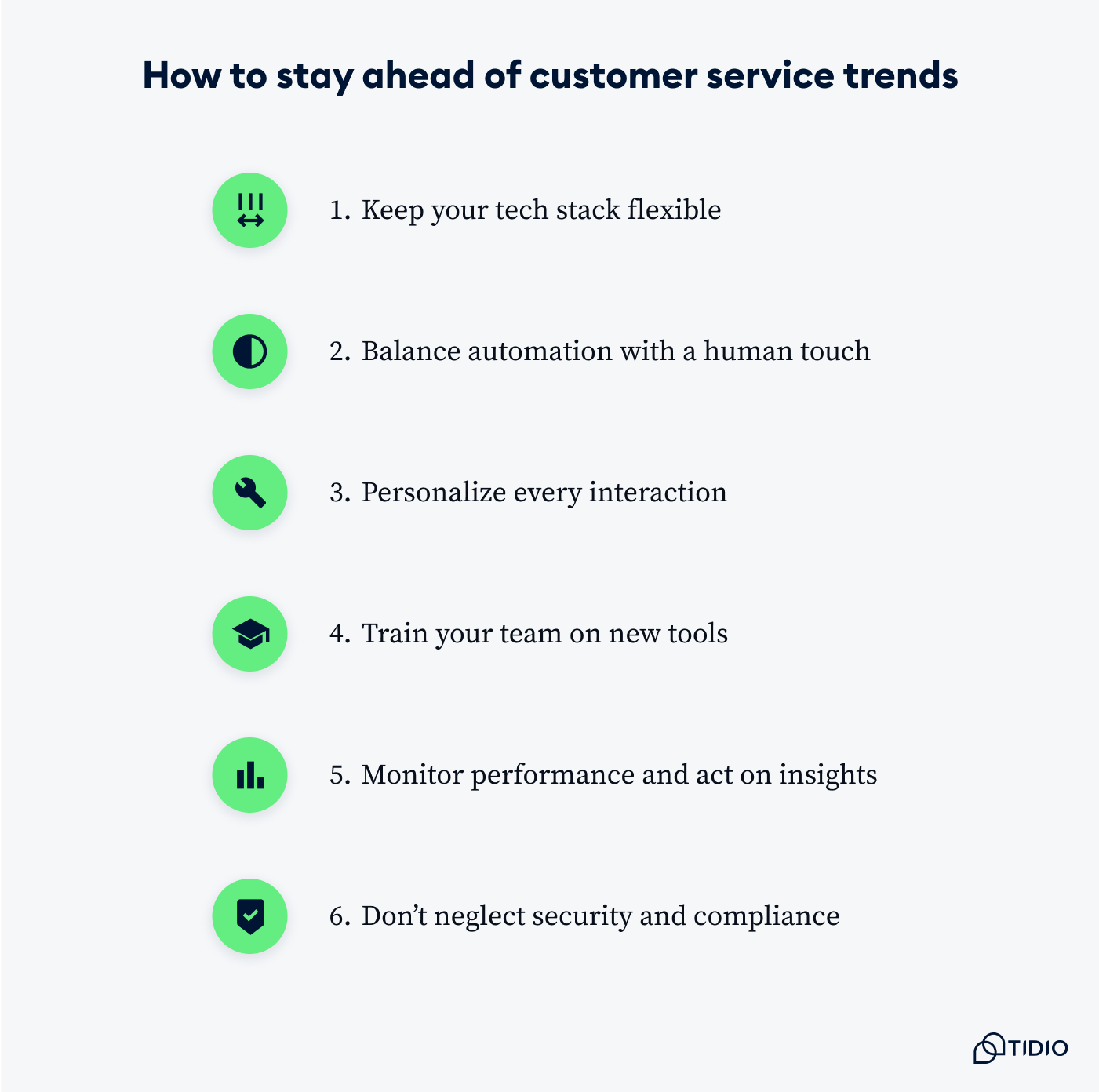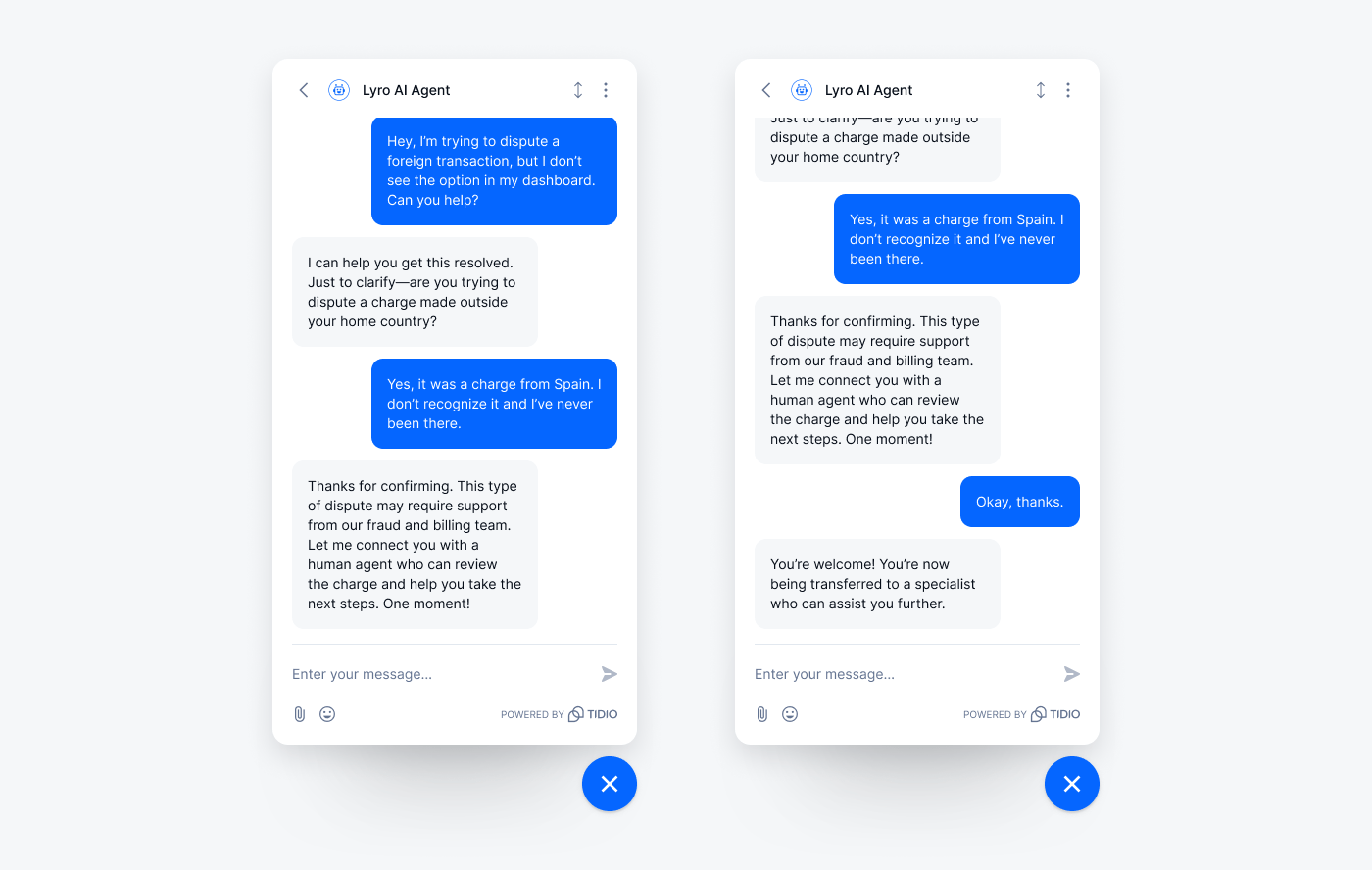AI is reshaping customer service, and it’s just the beginning. From automated conversations to smarter ticket routing, the biggest trend in support today is using AI to work faster and respond more effectively, without losing the human touch.
As customer expectations rise across channels like chat, email, and social media, businesses need systems that not only keep up but also adapt in real time. In fact, 87% of consumers say they trust a company more when it delivers an excellent customer experience (Hyken), making it clear that how you support customers matters just as much as what you sell.
In this article, we’ll break down the most important customer service trends and show you practical ways to stay ahead, so be sure to read on.
Stay ahead of customer service trends with Lyro
AI becomes a core part of customer support
AI isn’t just handling conversations on its own anymore. It’s also becoming a smart virtual assistant for human agents. More teams are turning to AI copilots to help draft replies, summarize tickets, or suggest relevant answers on the spot. It’s a quiet shift, but one that makes a big difference in how fast and confidently agents can respond. In fact, support agents who use AI copilots are 20% more likely to feel empowered to do their job well, especially in busy inboxes of fast-paced live chats.

Lyro Copilot is a great example of this in action. It works behind the scenes to suggest replies based on your data sources, giving agents a head start while still letting them review and edit responses before sending. When no data is available, Copilot can even offer a smart improvisation, clearly marked so agents know to double-check it. The blend of automation and human input saves time without sacrificing accuracy or brand voice.
At the same time, AI agents are taking on more responsibility in direct conversations. They can now handle longer, more complex queries by pulling from knowledge bases, capturing leads, and offering support 24/7. You can keep them up to date by uploading new content or reviewing flagged questions to improve future responses.
In fact, nearly 70% of CX leaders believe AI customer service agents are becoming skilled at delivering personalized experiences (Zendesk), making tools like Lyro a practical step forward.
Read more: Learn the steps to create a solid knowledge base chatbot.
Proactive support becomes the norm
Support used to be something customers had to go looking for. Now, more people expect businesses to reach out right when the problem occurs. Whether it’s a delivery delay or a drop in product usage, catching it early can make all the difference.
Proactive customer service tools help companies step in at the right time. In fact, 95% of companies that invest in proactive customer service report improved customer retention.

Read more: Explore key elements, types, and benefits of the AI knowledge base.
Self-service is now the first choice
Customers don’t always want to reach out for help. In many cases, they’d rather find answers on their own, quickly and without having to explain their issue twice. That’s why self-service is becoming a core part of the customer experience. Nowadays, companies are putting effort into building smart, searchable help centers and training their AI tools to answer questions clearly and consistently. In fact, 67% of customers prefer self-service over speaking to a company representative.

And it matters. According to Coveo, 56% of consumers rarely complain when something goes wrong—they just leave. Giving them the tools to find answers on their own helps prevent frustration and builds quiet loyalty that’s easy to miss until it’s gone.
Read more: Explore the topic of customer self-service and learn best practices for effective self-service management.
Omnichannel support expectations grow
Customers don’t think in terms of “channels.” They just want to get help, and expect the conversation to stay consistent, even if it starts in live chat, continues over email, and moves to a social media message later.
To keep things seamless, businesses are focusing on connected tools that store and sync conversations in one place. For example, smart routing ensures customers reach the right person, and shared context makes it easier for agents to pick up where the last interaction left off. On top of that, tools like Lyro can handle simple questions across multiple channels, making it easier to manage high volumes while keeping the experience cohesive.

Customer habits reflect this shift. Research shows that over 50% of customers use 3–5 channels on their way to making a purchase or getting a request resolved. In one example, users trying to book accommodations switched between websites and mobile apps nearly six times before completing the process.
Read more: Here’s all you need to know about multichannel customer service.
Personalization becomes a baseline expectation
A generic “How can I help you?” no longer suffices. Today’s customers expect support interactions to be tailored to their preferences, past orders, and behaviors. They anticipate relevant, personalized experiences without the need to reiterate their history. In fact, 70% of consumers expect anyone they interact with at a company to have a full context of their purchase history and previous interactions (Zendesk).

That’s why many companies are investing in AI tools. Solutions like Lyro can access product data to tailor answers automatically, creating experiences that feel personal. Lyro stays grounded in your content, so it doesn’t make things up or go off-script, which is something that helps maintain accuracy and build trust.
It can even adapt to your brand’s tone of voice, which keeps conversations consistent across channels. In fact, as many as 87% of consumers say they trust a company more if it provides excellent customer service, and relevance and reliability play a big role in that.
Read more: Learn how to make a compelling chatbot persona.
Transparent data practices gain importance in B2B
As more interactions move online, people want to feel confident that their information is safe and handled with care. Businesses that don’t prioritize this risk losing customers who are ready to walk away after even one unsettling experience.
That’s why transparency and clear communication around data practices matter. Customers are more likely to stick with brands that show respect for their privacy and explain how their data is used.
In fact, 94% of organizations state that customers would not buy from them if they did not protect data properly, emphasizing the importance of strong privacy practices. If your AI or support software collects customer information, make sure it meets compliance standards and keeps data secure.
Read more: Find out what makes a website trustworthy.
Agent enablement becomes a strategic focus
Customers notice when support is seamless and reliable. In fact, according to research, 79% of consumers would switch to a different company if it offered a better customer experience. On top of meeting rising expectations, businesses are realizing the importance of giving support teams the tools and systems they need to meet those expectations consistently. Whether that means integrating AI chat or streamlining internal workflows, companies that prioritize agent enablement are better positioned to deliver fast, accurate, and consistent support.
And that support goes both ways. As many as 56% of customer service agents say they experienced burnout at work, emphasizing just how important it is to invest in agent well-being.
Empower your support team with Lyro AI Agent
How to stay ahead of changing customer service trends
Customer expectations shift fast, and it’s easy to fall behind if your service strategy stays static. But this doesn’t mean you should chase every customer service trend. Rather, it means making smart choices that keep your team ready and your tools reliable.
These strategies can help you stay on track while building a support experience that actually works for your customers.

1. Keep your tech stack flexible
A rigid setup slows everything down. Whether you’re adding new channels, switching CRMs, or testing out AI tools, your tech stack should make changes feel manageable. Choose platforms that are easy to integrate and adjust as your needs evolve. For example, Lyro connects with your existing help center and lets you feed in updates without needing to start from scratch.
2. Balance automation with a human touch
AI is a great support tool, but it works best when paired with thoughtful handoffs and clear escalation paths. Customers still want real conversations, especially when something goes wrong. In fact, a survey found that 52% of customer support professionals observed that their customers prefer communicating with human support representatives due to the empathy and understanding humans provide.
Lyro helps strike that balance by handling common questions through automation while smoothly passing complex cases to live agents. This approach ensures that customers receive efficient service for straightforward issues and compassionate, personalized assistance when they need it most.

Read more: Find out the key benefits of using chatbot automation.
3. Personalize every interaction
Customers expect you to remember what they’ve done and then respond accordingly. Integrating tools like CRM systems and using conversation history helps make each reply feel relevant. Lyro pulls from your data sources and can be configured to match your brand’s voice, so answers feel personalized without sounding robotic.
Read more: Learn the differences between a CRM vs. ticketing system.
4. Train your team on new tools
Rolling out new software is only helpful if your team knows how to use it. Set time aside for training and let your agents explore your AI tools in a low-pressure environment. When agents feel confident navigating new systems, it reduces errors and leads to smoother interactions for everyone.
5. Monitor performance and act on insights
Dashboards and reports are extremely useful, but you need to check them regularly. Watch for patterns like rising handoff rates or slow reply times, then make adjustments. Tools like Lyro’s analytics help you understand what types of questions it handles well and where customers get stuck. This way, you can improve responses and add missing info where needed.
6. Don’t neglect security and compliance
Trust is fragile. Make sure your customer data is protected with reliable security standards and transparent practices. If you’re using an AI agent, check that they don’t store or leak sensitive information, and keep your data sources accurate and up to date. The more proactive you are about privacy, the more confident your customers will feel.
New customer service industry trends: get started with the right platform
Trends come and go, but the right platform gives you the foundation to adapt without the hassle. If your tools are clunky or disconnected, it’s harder to keep up, let alone improve how your team works.
Platforms like Tidio, with Lyro AI Agent built in, are designed to grow with you. You can automate support, manage conversations across multiple channels, and stay flexible as customer expectations evolve. Whether you’re looking to boost response times or personalize interactions, starting with a smart, scalable platform makes all the difference.
Ready to future-proof your support? Try Tidio with Lyro and see how effortless great customer service can be.
Empower your support team with Lyro AI Agent

